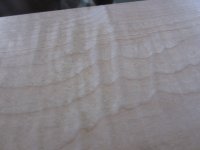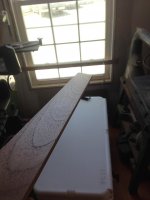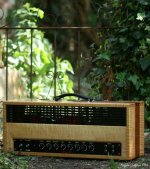richard newman
Titanium
- Joined
- Jul 28, 2006
- Location
- rochester, ny
Finally got around to some planing tests. Material was heavily figured hard maple, .280 thick x 3" wide, took .010 - .015 cut
First ran thru my old SCM S50 w/ 4 hss knives, kinda sharp. Got what I expected, a fair amount of tear out no matter which direction I sent it thru.
Then off to Will Tracey's shop and his modern SCM with Tersa head, digital read-out, GPS, and WiFi. Knives had some use on them, but seemed fine. Got about the same amount of tear out. Will generously volunteered to swap the knives out for fresh ones (took about 3 minutes - nice!) Sent the maple thru, results once again comparable to my planer. Hmmm…. Was disappointed, but not really surprised. I'd always felt my machine worked really well with thin and curly material.
Got back to my shop, decided to run it over my 6" jointer w/ Shelix head. Kinda hairy running something so thin and fluttery, don't try this at home. Was surprised by the result - no tear out! I bought the machine used, haven't swapped or turned inserts, you can see a raised line where the knives are chipped. I suspect that's how these deteriorate, chipping rather than dulling.
Pix show the Tersa and Shelix cut, same place on the lam, same lighting, same direction feed.
I'm convinced now that the Shelix or similar shear cutting insert head is what I need for planing thin curly stuff, just have to figure out what machine it should be in. Still not inclined to spend $3K to retrofit the 20" SCM just to plane 3" wie stock.
First ran thru my old SCM S50 w/ 4 hss knives, kinda sharp. Got what I expected, a fair amount of tear out no matter which direction I sent it thru.
Then off to Will Tracey's shop and his modern SCM with Tersa head, digital read-out, GPS, and WiFi. Knives had some use on them, but seemed fine. Got about the same amount of tear out. Will generously volunteered to swap the knives out for fresh ones (took about 3 minutes - nice!) Sent the maple thru, results once again comparable to my planer. Hmmm…. Was disappointed, but not really surprised. I'd always felt my machine worked really well with thin and curly material.
Got back to my shop, decided to run it over my 6" jointer w/ Shelix head. Kinda hairy running something so thin and fluttery, don't try this at home. Was surprised by the result - no tear out! I bought the machine used, haven't swapped or turned inserts, you can see a raised line where the knives are chipped. I suspect that's how these deteriorate, chipping rather than dulling.
Pix show the Tersa and Shelix cut, same place on the lam, same lighting, same direction feed.
I'm convinced now that the Shelix or similar shear cutting insert head is what I need for planing thin curly stuff, just have to figure out what machine it should be in. Still not inclined to spend $3K to retrofit the 20" SCM just to plane 3" wie stock.








